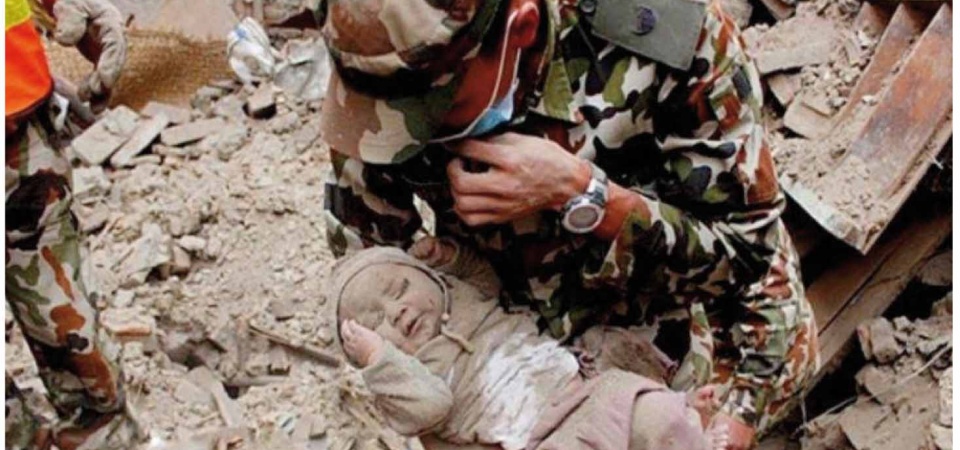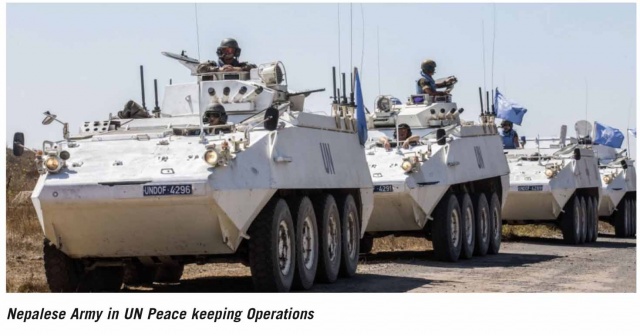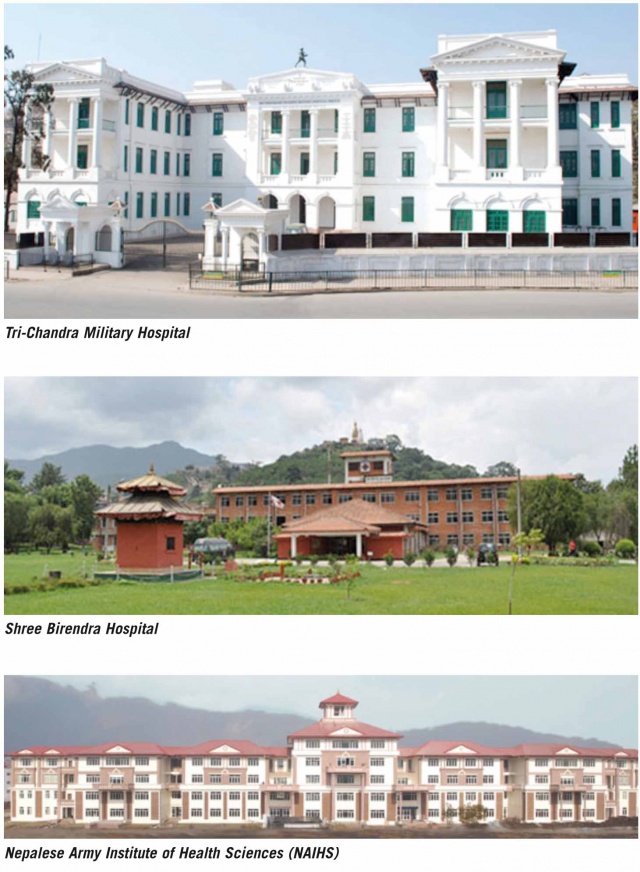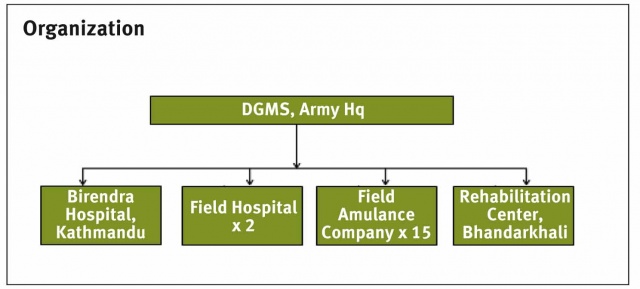

Article
Nepalese Military Medical Service
Directorate General of Medical Services is the highest authority to oversee the medical services within the Nepalese Army. Medical services in Nepalese Army started in 1925 with the establishment of Tri Chandra Military Hospital in Kathmandu. Later in 1990, the establishment of 490 bedded multispeciality Shree Birendra Hospital in Chhauni, Kathmandu commemorates the expanding medical services in the organization.
Basic Task of the Military Medical Service
Medical Support
nnMedical treatment
nnPrevention and promotion of health
nnPeriodical Health checkup
nnConduct medical camps
nnParticipate in outdoor exercises
nnStandby duties for VVIPs
nnMedical support during disaster, natural calamities, mass casualties and epidemics
nnMedical support during Insurgencies
nnUN Peace Keeping Mission: Pre deployment Medical checkup, Force Medical Officer & Establishment of UN Level 1 hospital in the mission area

Structure
Nepal Army Medical Corps
Directorate General of Medical Services is the highest authority to oversee the medical services within the Nepalese Army. Medical services in Nepalese Army started in 1925 with the establishment of Tri Chandra Military Hospital in Kathmandu. Later in 1990, the establishment of 490 bedded multispeciality Shree Birendra Hospital in Chhauni, Kathmandu commemorates the expanding medical services in the organization.
Nepal Army Medical Corps with 2 449 uniformed personnel is spread all over the country providing free medical care to NA personnel, retired army personnel and their dependents through its tertiary level Shree Birendra Hospital, 2 Field Hospitals, 16 Field Ambulance Companies, 2 GOPDs, Rehabilitation Centre and 7 small medical units spread all over the country.
Nepalese Army has been providing free medical services to retired army personnel and dependents of serving and retired army personnel since 1976 through Nepalese Army Welfare Scheme.
Military Hospitals
Tri-Chandra Military Hospital
Tri-Chandra Military Hospital was established in 1925 in honour of Nepalese soldiers who dedicated their life in the First World War. Besides the historical identity and its architectural grandeur, TCMH has many more glories attached to its name. It was the first hospital to introduce fiber optic endoscope services and establish semi automatic pathology lab in the country. Its upgraded services were shifted to Shree Birendra Hospital in Chhauni, Kathmandu in 1990 availing new technology and treatment modalities like MRI and Extra corporeal shock wave lithotripsy (ESWL), multi slice helical CT for the first time in Nepal.
However now the hospital is being totally reconstructed and planned to be utilised for medical as well as other purposes.
Shree Birendra Hospital
Shree Birenda Hospital (SBH) is a 490 bedded multidisciplinary tertiary level teaching hospital of Nepal Army with specialty services. This hospital is commanded by Brigadier General directly under Director General of Medical Services with administrative and a clinical registrar to support him.
Specialist Services
Surgery
nnGeneral Surgery
nnNeuro Surgery
nnCardio-Thoracic Surgery
nnUro Surgery
nnOrthopedic Surgery
nnENT
nnEye
nnGynecology & Obstetrics
nnPain Clinic
nnDental
nnPhysiotherapy
nnForensic Medicine
Medicine
nnGeneral Medicine
nnEndocrinology
nnOncology
nnCardiology
nnNephrology
nnPsychiatry
nnPediatric
nnRespiratory Medicine
nnDermatology
nnFood and Nutrition
nnPreventive and Social Medicine
Beneficiaries
nnServing NA Personnel and their dependents
nnRetired NA Personnel and their dependents
nn(Dependents: spouse, 2 children below 21 yrs, father & mother)
nnOfficer cadets and recruits
nnMinistry of Defense & Defense controller personnel & spouse
nnCivil staffs of NA
nnPersonnel of National Investigation Department
nnReferred Pts. from Nepal Police & APF Hospital
nnCivil Staffs & Students of NA School & College
nnForeign army personnel undergoing training in NA & Spouse
nnCivilians: Emergency management
nnCivilians of Natural Disaster & Calamities
Nepalese Army Institute of Health Sciences (NAIHS)
NAIHS is a service oriented non-profit making institution with College of Medicine and College of Nursing and upcoming Medical Polytechnic School and a College of Dentistry. NAIHS is committed to produce quality health professionals in respective disciplines not only for the army but for the nation as a whole at an affordable cost.
The concept of NAIHS originated with the imminent need to improve patient care system within Nepalese Army Medical Corps, which could only be achieved by igniting medical potentialities of its health professionals with academic fire by having a medical institute of its own. There is an acute short fall of the qualified health professionals in the country and Nepalese Army Medical corps (NAMC) is no exempt.
Medical education is becoming expensive everywhere and is practically out of reach for most people. NAIHS has offered the opportunities of standard medical and health science education not only for deserving candidates from army (serving and retired) but also for the qualified civil candidates.
NAIHS – College of Medicine (COM) offers MBBS program comprises of 4.5 years of study and a year of internship. NAIHS- College of Nursing (CON) runs PCL nursing, BN and B.Sc.(Nursing) . Shree Birendra Hospital (SBH) at Chhauni which is a 490 bedded multidisciplinary modern referral hospital of army serves as the center of excellence to undertake all clinical teaching/learning activities for these programs. Addition of a 450 bedded Veterans & Civil Hospital in the near future within the premises of TCMH, Mahankalsthan will further strengthen the institute.
NAIHS Components
nnNAIHS – College of Medicine
nnNAIHS – College of Nursing
nnNAIHS – College of Medical Polytechnic
nnNAIHS – College of Dental Surgery
Training / Education
Doctors: (NAMS & NAIHS)
nnInternship for MBBS (from 2017)
nnPost Graduate Education MD/MS
(will be starting soon)
nnMBBS doctors – NAIHS
Nurses: (NAIHS)
nnCertificate Level (Staff Nurse) Training
nnB.N. and B.Sc.
Paramedics: (NA & CTEVT)
nnBasic Courses
nnDepartmental Courses
nnSpecialized Courses
Field Deployments / Missions
UN Peace Keeping Operation
Nepal Army has active participation in most UN Peace Keeping Operations and ranks sixth in the world as Troop Contributing Countries. The participation of the Nepalese Army in UN peace support operations spans a period of over a half century covering some 41 UN missions, in which over 113,698 personnel have participated. The army’s long association with UN peace support operations began with a modest deployment of five military observers in Lebanon in 1958. As of October 02, 2016, the Nepalese Army has deployed across 15 missions around the world. Currently, it has some 4,403 soldiers including 111 female soldiers serving in 15 different missions around the globe and providing medical care to the peace keepers as well as the local civillians through 10 Level I Hospitals and clinics. During it service to the Peace Keeping Operations, 63 soldiers have sacrificed their lives and 59 have been injured.

Civil-Military Cooperation
Nepal Army in Disaster Relief
Nepal is prone to various types of natural disasters due to her rugged and fragile geophysical structure, very high peaks, high angle of slopes, complex geology, variable climatic conditions, active tectonic processes, unplanned settlement, increasing population, weak economic condition and low literacy rate. It is a great challenge to the nation to protect infrastructure and property from frequent landslide and floods. Each year flood, landslide, fire, epidemic, avalanche and various other natural and man made disasters cause the casualty of thousands of human lives and destruction of physical properties worth billions of rupees.

The Government of Nepal views the Nepalese Army as an inseparable agency in Disaster Relief Operations. Examples of the particular suitability and capability of the armed forces to respond effectively to such incidents abound in Nepalese history. Furthermore, Nepal's status as a developing country does not justify the high costs of maintaining a separate disaster relief organization. Consequently, the Nepalese Army plays a major role in providing emergency assistance to needy people all over the country – a role that has become even more important following the recent Gorkha earthquake 2015 in which 8,891 persons lost their lives, 22,302 were injured with property worth US$5 billion (5% of GDP) lost.
Date: 10/18/2017
Source: MCIF 4/16










